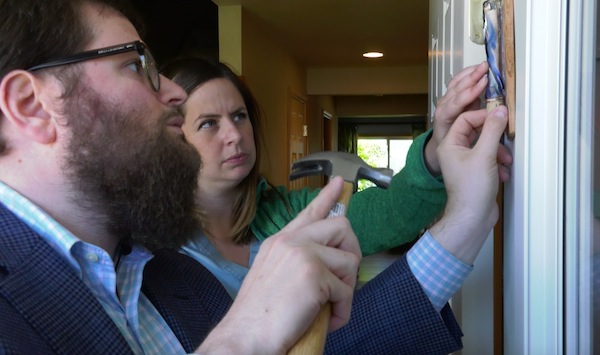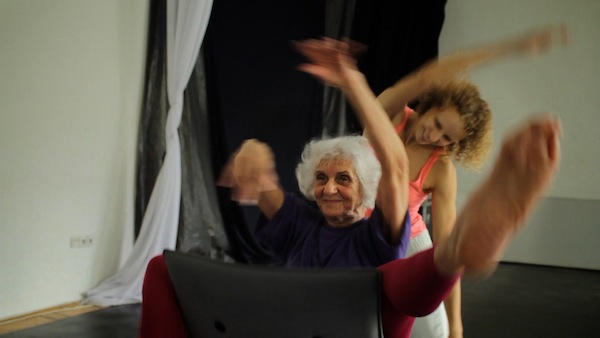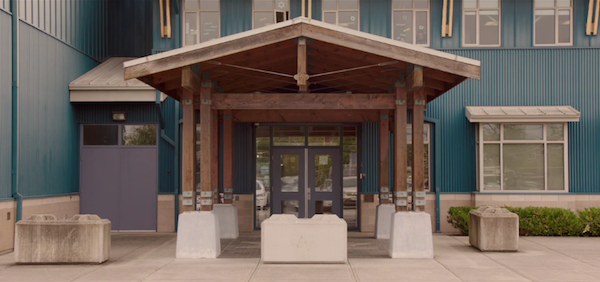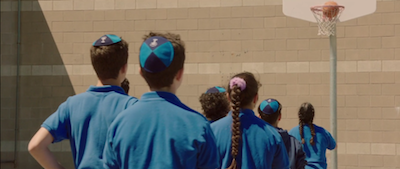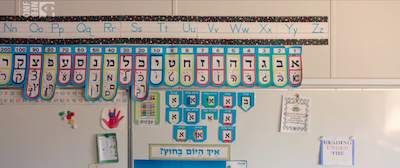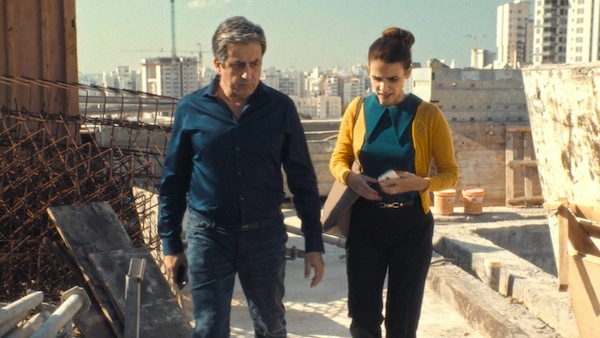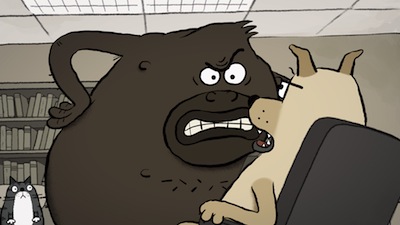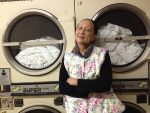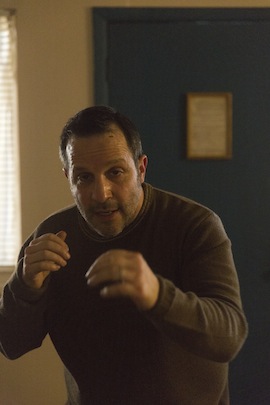Actor Ching Valdes-Aran in a scene from The Washing Society. (photo from The Washing Society)
Faced with the challenge of making a documentary for which the voices of undocumented immigrants were crucial, filmmakers Lynne Sachs and Lizzie Olesker had to push the boundaries of convention. The result is The Washing Society, which will see its Canadian première at the Vancouver International Film Festival, as part of the festival’s Impact programming.
“For this year’s Impact stream, we decided to foreground films that represent prominent themes found in the festival at large – themes that are extremely topical at this historical moment,” said Alan Franey, director of international programming at VIFF, in a release. “Refreshing in their cinematic artistry, insights and lack of platitudes, these films have the power to inspire actual change.”
The Washing Society combines research, interviews, acting, dance, artistic images and other elements to introduce viewers in 45 minutes to some of the laundromats in New York City, which are disappearing, and the people who work in them. Olesker and Sachs, who both live in Brooklyn, will be in Vancouver for the festival and the Independent interviewed them by phone in anticipation of their visit.
The filmmakers are practically neighbours, and they met each other through their daughters, who are about the same age and have the same piano teacher. It was at a piano lesson where they first crossed paths. “Then we saw each other’s work, and really admired what each other were doing,” said Olesker.
The origins of the documentary are in a performance Olesker was commissioned to do in a laundromat, upon which she wanted to expand. Thinking that film would be a good element to add to it, she contacted Sachs.
“We had a series of conversations, which led me to unexpected places in how to think about laundry and women doing laundry, and so it became a deeper, more fruitful collaboration,” said Olesker.
Over a span of about two years, the pair researched the topic, then co-created the play Every Fold Matters with the actors performing it, as well as writing their own text. The site-specific performance and film project – which was performed in laundromats and various venues throughout New York from 2015 to 2017 – formed the basis for what has become The Washing Society.
“We’ve been working together now for probably over four years,” said Sachs, “because we spent almost a whole year traipsing all over New York City – mostly Brooklyn and Manhattan – trying to do the convention of documentary practices, ‘Let’s go into laundromats, let’s talk to workers.’ But the issues in New York are that so many of those workers are undocumented, so they’re very hesitant to have a conversation in front of a camera. So, we would have conversations and we would go back and write pieces and create characters based on all of those interviews we did, which we didn’t film. But then, over the course of time, as it shifted from being a live performance with media to a film, we got better at finding people who were willing to speak in front of the camera.”
They did this, in some cases, with the help of an actor or a translator, who then became more involved or involved in other ways. “One of the things both of us are really interested in,” said Sachs, “is breaking down the conventions of roles in the project.”
Both Sachs and Olesker have done cross-disciplinary work before.
“It’s been exciting for me to work in film and also to engage in questions like, What is a documentary? What does it mean to inquire into a subject or have a question and pursue it in different ways? As a creator of film or theatre, you’re always looking for a truth, not necessarily the truth.”
“I’m really interested in how documentary crosses over into fiction, and how fiction informs the documentary aspect,” said Olesker. In this project, she said, “It’s been exciting for me to work in film and also to engage in questions like, What is a documentary? What does it mean to inquire into a subject or have a question and pursue it in different ways? As a creator of film or theatre, you’re always looking for a truth, not necessarily the truth.”
The Washing Society contains a lot of theatre. “That’s an issue that raises questions with audiences in good ways and in challenging ways,” said Olesker, for whom this film is her first foray into documentary-making.
Sachs, however, has made this type of documentary before, mixing lived experience with fiction; for example, Your Day Is My Night, which she brought to the Vancouver International Film Festival in 2013. “Working in this way,” she said, “has started to make me to question all forms of documentary, or even narrative film, because you see a narrative film and it’s really a document of a bunch of people getting together and making a fictional story.”
One passion “that has been very nourishing for both of us in our work is our relationship to history, to the historical document,” said Sachs.
“With this film,” she explained, “when we came across the story of the Atlanta washerwomen, we found it absolutely riveting and astonishing that there was this moment in American history in which a group of 3,000 black women had enough power or wherewithal or vision … to organize and to change their working lives. Any art project that gives you an excuse to research, I think, is pretty exciting.”
The title for the documentary is inspired by what these washerwomen accomplished in 1881. As for more recent history, The Washing Society both exposes the harsh working conditions in laudromats and laments the loss of these neighbourhood establishments.
“I think it’s interesting to explore that contradiction,” said Olesker. “It is grueling, underpaid, under-recognized work. It’s also necessary work – not necessarily in the form that it’s taken, of dropping off your laundry and paying someone to wash and fold it, but someone is always going to have to do the wash, so that sense of broad history and the roles that women have had in doing that work is something that was behind the project, as well.”
“My nostalgia,” said Sachs, “is any space where there is an intersection.… It’s what makes cities great, the idea that there is a space in which there are intersections, and that people who have less and people who have more are in the same space and they’re spending time [together]. And that all has changed so much now. The thing is, though, that the basic infrastructure – of there being a large group of people who are hidden in some way, and they are doing service work for other people, who have much more access or means – isn’t going to change because, even if it [laundry service] becomes an app, like we show at the end of the film, there are still people doing the work, they’re just not as visible.”
One purpose of the film is to make that invisibility visible. But, said Olesker, “What’s interesting about the film to me is that we’re not so much leaving you with something that we think should happen. We’re opening it up as a question and saying, ‘Look inside this.’ We looked inside and now we’re taking you inside, what is this about?”
There is a challenge to making a documentary when the “people who we would want to have in the movie are undocumented, therefore, they don’t want to be documented by us – they want to be documented by the government….”
In the United States, added Sachs, the idea of the document “comes down to a sense of security.” There is a challenge to making a documentary when the “people who we would want to have in the movie are undocumented, therefore, they don’t want to be documented by us – they want to be documented by the government, and so there is this resistance to being in front of our camera until they can find something that legitimizes their status here in another way that will serve them.
“And it actually comes down to the whole project of making art,” said Sachs. “To whose advantage is it? For example, we’re getting to go to Vancouver and we were talking about, Could we manage to bring one of the people from the film? There is a lot of questioning about what access the artwork gives. We’ve tried to bring along the people in the film as much as possible, but we aren’t always able to.
“There’s even a point in the film where we have Chinese and Spanish … sometimes we translated that and sometimes we didn’t, because we wanted to give opportunity for people who are in the audience who had access to those languages to feel that they were in positions of strength over the rest of us. There’s something about subtitling that, if you subtitle everything, you bring it all into the English window, and people stop listening.
“A big part of the film,” she continued, “is to go outside of issues of work and of cleaning in an urban situation, which becomes involved in service … [and to delve into] all the layers of existence or the layers of identity that happen in cities these days, and who listens to whom. We hear Spanish all the time [in the United States], but are we really listening to it or is it something we can just pass by? Same with Chinese.”
Both Olesker and Sachs are Jewish.
“I’m from New York so, growing up, it’s been a part of my life,” said Olesker. “Not in a religious way, but certainly in the culture of my family and my world. And specifically around labour and labour history, union organizing – not that anyone was an organizer in my family, but there was always an awareness of that, so that is part of my identity in terms of the work I’m interested in making.”
Sachs is a member of Kolot Chayeinu. “The rabbi and founder of the congregation – her name is Ellen Lippmann – she’s always been a hero of mine,” said Sachs. “She’s just retired, about a month or so ago, after 25 years running Kolot Chayeinu. It’s a very, very progressive congregation and I worked with her just a couple of years ago on something that I found very moving.”
Lippmann would often ask Sachs to film various activities for the synagogue and, in 2016, when B&H photo and video store, which is run by ultra-Orthodox Jews, was challenged by labour activists for the company’s treatment of its warehouse workers, “a bunch of people from Kolot decided to organize with the workers in front of B&H,” said Sachs. “I was there to videotape it and so were some television stations. And I think that Ellen Lippmann really wanted to say, this is not, to our mind, following an ethical frame of reference that we want to claim as Jewish.”
Olesker pointed out that the B&H walkout was organized by the Laundry Workers Centre. “So, we actually made a little film, which is kind of a postscript to The Washing Society, where they organize this march through east Harlem to a laundromat … where two of the workers who were part of the Laundry Workers Centre went in and presented a list of demands to the owners … to talk about unfair labour practices and long hours and being underpaid and no breaks. We were part of that march and demonstration, which Lynne shot on film and we edited.”
The video epilogue, as well as teasers for The Washing Society, can be found on vimeo.com. For the film festival lineup, visit viff.org. The festival runs Sept. 27-Oct. 12.

